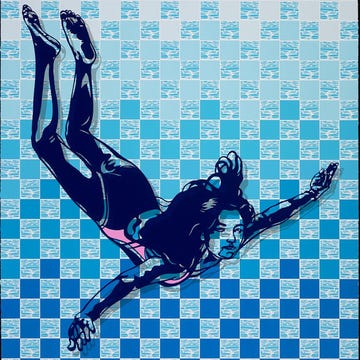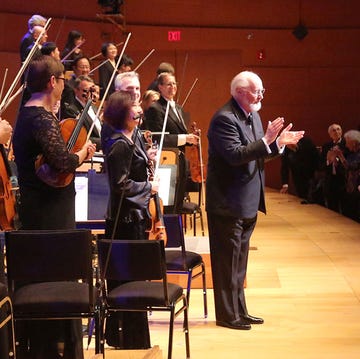When an Encyclopedia Britannica arrived at the Nassau home of then-10-year-old Tavares Strachan, he was impressed but perplexed. “I thought, How beautiful but how absurd,” the Bahamian artist recalls. “It’s like, How dare you? Who gave you the confidence to muster all of this knowledge and put it in one place?
“I thought, Well, if you could do that, then what are all the things that you’re not putting in? As I got older, I thought, Maybe we could make a place for all those things.”
Strachan’s 2018 sculpture Encyclopedia of Invisibility contains 17,000 entries, printed on opaque paper and bound in goatskin, selected and researched by the artist and his assistant. It is a massive tome featuring countless underrecognized figures, such as Black explorer Matthew Henson, who, with the better-known Robert Peary, was the first to set foot on the north pole. (During this interview, the 46-year-old bearded artist, visiting from his home in New York, wears his own black T-shirt bearing Henson’s name in white letters with black pants and bright yellow shoes.)
A selection of entries are mounted behind Plexiglas, stretching from floor to ceiling, at the entrance to Strachan’s exhibition The Day Tomorrow Began at the Los Angeles County Museum of Art (LACMA), on view through March 29.
A page from letter K defines “Kinetoscope,” “Kingdom of Benin,” and the last Anglo-Saxon monarch of England, “King Harold II.” The reference notes that the West African kingdom existed from the 11th century to “annexation by the British Empire in 1897.” The adjacent entry on the brief reign of an English king does not seem coincidental; this close reading of history is Strachan’s personal fascination.
Museum director and CEO Michael Govan was recently walking through the show looking intently at different sculptures and offered thoughts on Strachan’s pursuits. “Like Leonardo would pack his notebooks full of ideas about science and art and ruminations,” he says, “the Encyclopedia of Invisibility has science, it has history, it has art.”
Some 60 more pieces are on view at LACMA, which has supported the artist since a 2014 grant from the museum’s Art + Technology Lab helped him collaborate with SpaceX to launch a satellite into space containing a Canopic jar representing Robert Henry Lawrence Jr., the first Black astronaut, who died before the Apollo 11 journey. The artist remembers telling Govan, “I have this idea. I want to put an effigy of this astronaut who didn’t get to go into space into space. What might that mean?”
A Getty artist in residence in 2019 and a recipient of the MacArthur Foundation “genius” grant in 2022, Strachan says his interconnected interests in art and science began as a teenager in Nassau, working on a fishing boat. “One of the things that I became captivated with was the egalitarian exercise of stargazing,” he says. “No matter where you are, how much or how little you have, you can look up in the skies and study the stars.”
History, too, has a role in this exhibition, especially in what the artist calls Monument Hall, where eight sizable sculptures, half in bronze, invite new interpretations of historically heroic figures. The centerpiece is the nearly 16-foot-tall steel-and-resin In Praise of Midnight (Christophe x Napoleon). It gives supremacy to Henri Christophe, a Black leader of the rebellion against the French in Haiti, by mounting his figure atop the upside-down figure of Napoleon. Christophe, born in the British West Indies, and Napoleon, born in Corsica, both elevated themselves to royal status once in power.
Diana Nawi, the show’s curator, observes, “There is a lot of recuperation of history. I think once you start to go back and open those channels, there is the possibility that things can be different in the future. That’s for [Strachan] and for viewers.”
Strachan transformed the museum galleries into installations, staged in a way to conjure the spaces he occupied during childhood. One is starkly gray with washing machines churning and a white neon sign announcing, “The Wash House: Some loads are too heavy to carry alone.” Another is a re-creation of a barbershop but with black walls, black chairs, and, on occasion, costumed performers chanting and singing.
“I grew up with five brothers,” he explains. “We went to the barbershop, we went to the laundromat, we did the folding.… These are spaces that made a lot of the intellectual fabric of the communities where I was raised.”
By the age of 17, Strachan was making his first works of art, in ceramics and painting, as a student at the College of the Bahamas and Brown University, later getting his BFA in glass at the Rhode Island School of Design and his MFA in sculpture at Yale.
Though he is a conceptual artist, having affinities to West Coast artists like Robert Irwin and Chris Burden, the work still starts with drawing and craft. His carefully built ceramic sculptures are placed throughout the galleries.
Strachan studied art theory in school, though he has a healthy skepticism of such institutions. “You often learn to distrust your own instincts in the academy,” he says. “I oftentimes say that so much of my post-academic life has been about unlearning so much stuff that I spent so much money learning.
“I’m from a poor family, so no one had the privilege of being able to go off to do this thing. [I was] really struggling because I [could have done] something that is more practical,” he says of his decision to pursue art at 17. “I had this very emotional moment with my father in the kitchen. I said, ‘Pops, this is our family. I could go do something that might be a more obvious path for the safety of the rest of us.’ He said, ‘You can’t do that. You have to do the thing that you were born to do.’”•
THE DAY TOMORROW BEGAN
Through March 29, 2026
Los Angeles County Museum of Art
5905 Wilshire Blvd., Los Angeles
Hunter Drohojowska-Philp, the author of Rebels in Paradise: The Los Angeles Art Scene and the 1960s and Full Bloom: The Art and Life of Georgia O’Keeffe, has written numerous books and articles on modern and contemporary art with an emphasis on California and the West. They can be found at hunterdrohojowska-philp.com.














